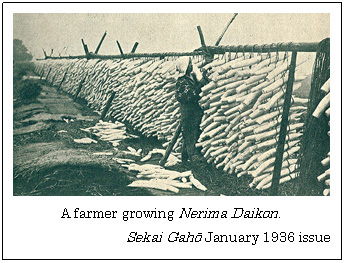About This Print
Number seventy-three of the one hundred prints that make up the series Showa dai Tokyo hyakuzue (One Hundred Pictures of Great Tokyo During Showa). Koizumi started this series in 1928 and completed it twelve years later in 1940. In this print, Koizumi pictures a farming couple at work pickling daikon, giant radishes. Najima was once famous for its daikon and the takuan pickles produced by the local farmers.Artist's Annotation
Source: MIT Visualizing Cultures website http://ocw.mit.edu/ans7870/21f/21f.027/tokyo_modern_02/annotation.htmlIn 1940, Koizumi created woodblock print charts containing print titles, dates, and comments for this series. His comment for this print follows:
“Daikon of Nerima have been renowned from thetime they were presented as gifts to the shogun. The priest Takuan introduced arecipe for pickling these radishes. So they became even more famous.”
Nerima Ward Today

Source: website of The Tokyo Foundation http://www.tokyofoundation.org/en/topics/japanese-traditional-foods/vol.9-japanese-radish
"Legend has it that the Nerima daikon originated from the seeds that Tokugawa Tsunayoshi, the fifth Tokugawa shogun, ordered from Owari to the capital for cultivation. But its shape and characteristics would seem to suggest that it is the outcome of generations of complex natural crossbreeding between a pre-existent local variety of Nerima and the variety brought from Owari, until a radish with favorable qualities was born.
Several factors played in its favor, leading to its active cultivation. The soil in Nerima is part of the Kanto loam layer, consisting of volcanic ashes from Mt. Fuji and ideal for daikon cultivation. The radish had superior qualities as a takuan pickling vegetable. Moreover, it became the designated daikon for payment in kind to the Tokugawa shogunate. Production volumes increased in the Meiji era (1868-1912), as large quantities of takuan made from Nerima daikon were supplied to the army during the Sino-Japanese and Russo-Japanese wars (1894-95 and 1904-1905) as garnish for the rice balls eaten by soldiers. Consumption further grew between the Taisho era (1912-1926) and the beginning of the Showa era, and up to 500,000 Nerima daikon were annually produced in the peak years. From around the mid-1950s, however, the tide reversed.
In 1989 a program was jointly started by the Nerima Ward, farmers, and agricultural cooperatives to save the Nerima daikon from extinction. Today, as in the old days, most of the harvested radishes are pickled. The Nerima daikon is sown between late August and early September and harvested between late November and early December. Prior to pickling, the daikon is sun dried for 10 to 14 days in the cold, depending on the weather, after having the soil washed away and its skin scraped off with shark skin or a similar tool to facilitate drying. Once thoroughly dehydrated, the daikon is taken to picklers and becomes takuan.
Furthermore, some farmers are individually engaging in unique efforts. Yoshitaka Shiraishi, in addition to growing Nerima daikon under commission from the ward, is also trying to reproduce the original Nerima daikon; the currently known Nerima daikon is actually a hybrid developed by a seed and nursery company. Shiraishi hopes to open the door to the past and bring back to life the true, original form of the Nerima daikon."
| IHL Catalog | #974 |
| Title | Landscape at Nerima Ward 板橋区・練馬風景 - Kanji title upper left margin |
| Series | One Hundred Pictures of Great Tokyo in the Showa Era Showa dai Tokyo hyakuzue 昭和大東京百図絵 |
| Reference Number | #73 (artist's annotated portfolio list from c. 1940) |
| Artist | Koizumi Kishio (1893-1945) |
| Signature |  |
| Seal | |
| Publication Date | originally November 1935. This print may be post-WWII edition. |
| Edition | unknown |
| Publisher | likely self-published; some sources list publisher as Asahi Press (see "The Publisher of the Series" under the artist's bio Koizumi Kishio.) |
| Impression | excellent |
| Colors | excellent |
| Condition | poor - toning and heavy mat line; mounting residue in corners of top margin; paper loss top left margin; 3/4" tear upper right margin and into image, repaired from back; tape stains in corners verso |
| Miscellaneous | this print was mounted in an acidic mat as sold. "Made in Occupied Japan" was stamped on the back of the mat as shown below. This stamp was required to be placed on export items by the U.S. occupation authorities from late 1945 through the lifting of the order in April 1952. |
| Genre | sosaku hanga (creative prints) |
| Format | dai oban |
| H x W Paper | 12 x 15 1/2 in. (30.5 x 39.4 cm) |
| H x W Image | 11 1/8 x 14 3/4 in. (28.3 x 37.5 cm) |
| Collections This Print | The National Museum of Modern Art, Tokyo P00131-028; The Wolfsonian at Florida International University TD1993.69.1.29 |
| Reference Literature | Tokyo: The Imperial Capital Woodblock prints by Koizumi Kishio, 1928-1940,Marianne Lamonaca, The Wolfsonian-Florida International University, 2004, p. 98. |




